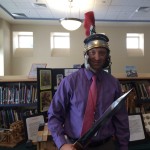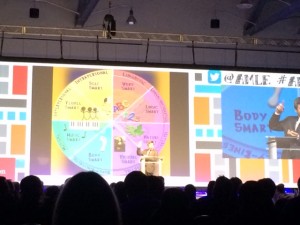 Two weeks ago I attended the annual conference of the Association of Middle Level Educators (AMLE). I have been working in middle level education for most of my professional career, but this was my first time at the conference.
Two weeks ago I attended the annual conference of the Association of Middle Level Educators (AMLE). I have been working in middle level education for most of my professional career, but this was my first time at the conference.
Overall, I had a fantastic AMLE experience. I was exposed to some interesting and important research. I was lucky to meet some incredible practitioners and heartened to hear about innovative practices being employed on behalf of young adolescents. I also spent some quality bonding time with my colleagues.
My generally positive experience, however, was slightly marred by what has become all-too-familiar at large education conference: disappointing keynotes.
The Echo Chamber
The first keynote I attended was an early morning session in a giant exhibition hall with 60 feet ceilings. Here’s a tweet I wrote during the session:
#AMLE2015 please figure out acoustics in Hall E – the echoes are killing @YongZhaoEd ‘s substance and humor!
— Life LeGeros (@lifelegeros) October 16, 2015
Others felt the same way about the echo-induced brain pain — that tweet got more attention than pretty much anything I’ve ever put on Twitter. (Sad but true.)
It strikes me that this echo-y session in particular was a bit of a metaphor for the various ways I find my high hopes repeatedly dashed by bigwig keynotes:
- Echoes of “amen” from the choir – Too often these talks are one sided affairs with no consideration of other perspectives or, more importantly, no chance for the audience to share perspectives with those around them in order to gain insight.
- Echoes as repeats – It is rare that one of these talks presents any material that is not already present in another form: book, online lecture, website, etc.
- Echoes off in the distance – When the audience or occasion isn’t considered, and the canned slideshow is rolled out with a new title slide, it’s difficult to feel engaged, or even fully respected.
Add to this litany of complaints that keynotes in education usually have a hypocritical streak to them, since nobody is advocating for long slidehow-based lectures as good pedagogy.

Keys to a Good Keynote
To be clear, I am not against keynotes. I do see huge potential for crowd-sourced formats such as Unconference and EdCamp , which because of their just-in-time natures do not have keynotes by definition. Yet I believe there is still a place for the type of big picture preplanned kick-off sessions that keynotes offer.
At the week long Middle Grades Institute 2015 here in Vermont, for example, Monday morning featured a powerful keynote co-presented by a teacher and student. The presentation provided concrete examples of pedagogical possibility and sufficient glimpses into their special student-teacher relationship that many of us were near tears.
Although the rest of the week was participant-driven in the EdCamp mold, this initial session fulfilled the central functions of a good keynote: it established a theme, provided a touchstone, and included compelling content that challenged, inspired, and moved us.
The best bigwig keynote example I personally experienced was delivered by Michael Fullan. He made liberal use of age old pedagogical strategies such as “turn-and-talk” to make it into a dynamic learning experience.
Even at the potentially self aggrandizing “Educators to Learn From” annual EdWeek shindig, you can see him asking the audience to think together and then watch him genuinely interact with their ideas. (Check the 40 minute mark for his prompts, and/or watch the whole thing for a fascinating discussion of ed tech’s role in systemic reform.)
A Final Plea
So, all of you A-List education presenters out there, please heed my call to step up your game. I know that you are very busy, and that you have tried to create presentations that are entertaining and that succinctly hit your main points, but I’m asking for more. In most cases attendees have showed up at your sessions because we already like your ideas. You have us in the palm of your hand – so please bring your A game, challenge yourself in order to challenge us, so that we can rethink and improve and do better for our students.


The Lost Art of Educational Keynoting by @lifelegeros https://t.co/wxpRQZqXyz https://t.co/pPIKE75JYo
http://tiie.w3.uvm.edu
RT @innovativeEd: The Lost Art of Educational Keynoting by @lifelegeros https://t.co/wxpRQZqXyz https://t.co/pPIKE75JYo
The lost art of educational keynoting – What and How https://t.co/GAgqP4e1Q0 #education #meetings